Poor-class meat cuts, blood, kidney are making it to puddings, tacos and pasta. Have the heart to taste?
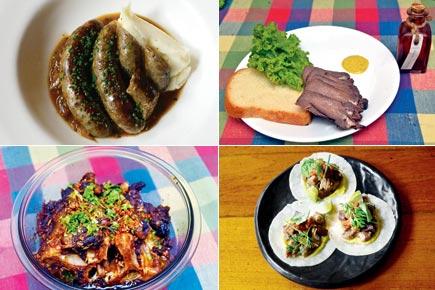

ADVERTISEMENT
Beef eating rules in India are hazy under a blur of political upheaval, and food experts say we have testing times ahead. In a parallel world, professionals and home chefs in the city are focusing on zero wastage of an animal or bird, and pushing the concept of nose to tail which involves consuming the offals and off cuts of any meat, whether buffalo, pig, goat or chicken.

Gresham Fernandes, culinary director at Impresario, in Mumbai, says a lot of people are converting to non-vegetarian food, and so their initial choice is usually fish and chicken. "The lower strata, however, has been eating these cuts for the longest time. There is nothing exotic about it," he grins. Take an early morning walk to the butcher, he suggests. "You will see that people are mostly buying off cuts. It is a cultural thing," says Fernandes who spearheads Swine Dine, a concept of nose-to-tail pork pop-up at Jude Bakery and Salt Water Café in Bandra.
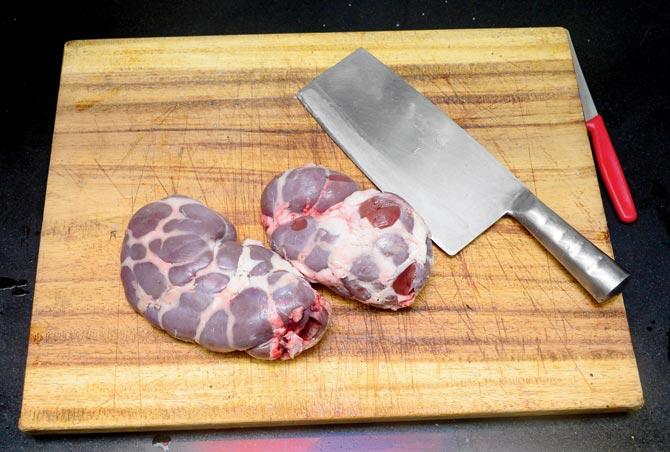
At the restaurant, says Fernandes, off cuts has no takers. That is why a pop-up format, like the one coming up next month, works best. Customers at restaurants, however, prefer the expensive cuts, like the shank, leg, breast or chops, and shun offals (entrails and internal organs, also called off cuts) chef Manu Chandra observes.

"At our Bangalore outpost of Toast and Tonic, almost every table orders the Chicken Liver Pate. In Mumbai, this dish hasn'tmoved much. We used to use the heart and gizzard in sauces at Monkey Bar, but not in the obvious form. The off cuts seem vastly popular at the Mohammed Ali Road food stalls famous for jabaan (tongue), bheja (brain), trotters (legs), kaleji (liver), and dil (heart)," he adds.
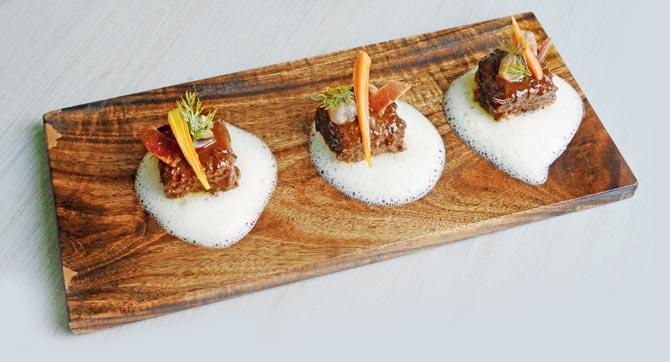 Buffalo cheek cut at Slink. Pic/Suresh Karkera
Buffalo cheek cut at Slink. Pic/Suresh Karkera
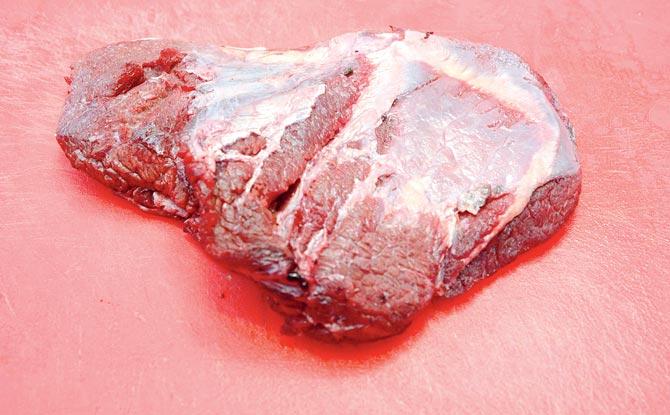 Buffalo cheek cut at Slink. Pic/Suresh Karkera
Buffalo cheek cut at Slink. Pic/Suresh Karkera
Buffalo Cheek Bourguignon at Slink & Bardot
At Slink and Bardot, all meats are served with their own jus (i.e. juice). Mirepoix, the French holy trinity, comprising onion, celery and carrot, is added to roasted bones to make a stock, which is then reduced to a thick jus. Chef Alexis Gielbaum uses a secondary cut of meat, the cheek, for his take on the classic Boeuf Bourguignon. You'll recall this dish from the film Julie and Julia.
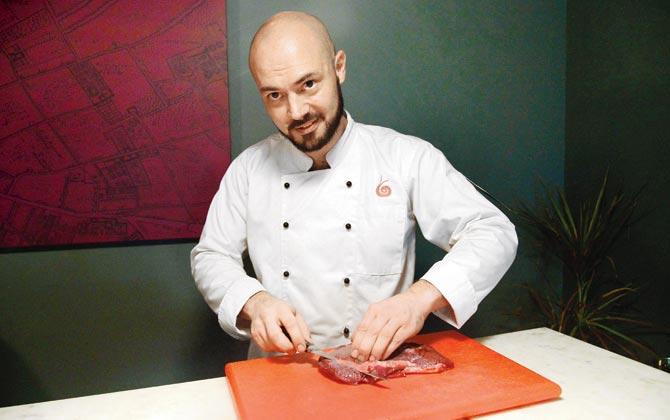 Chef Alexis Gielbaum. Pic/Suresh Karkera
Chef Alexis Gielbaum. Pic/Suresh Karkera
"It is marinated in red wine for 12 hours and braised slowly on gentle heat with garlic and a bouquet garni. This means a bouquet of leek, thyme, bay, parsley and celery leaf," co-founder Nick Harrison explains.
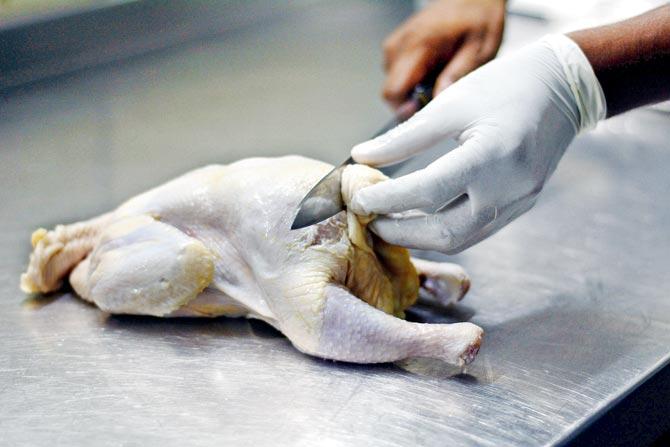
Parson's nose at Swey. Pic/Bipin Kokate
Parson's nose at Swey
Gaurav Dabrai first tried a chargrilled version of parson's nose unknowingly. "My chef asked me to try it, and I quite liked it. The moment I knew it was the flesh around the rump of the bird, I frowned," says the co-owner of Swey, adding that it tasted like a chicken piece, if a little chewy. Chef Sagar Thite prepares it with a homemade teriyaki sauce along with honey, soy and paprika powder.
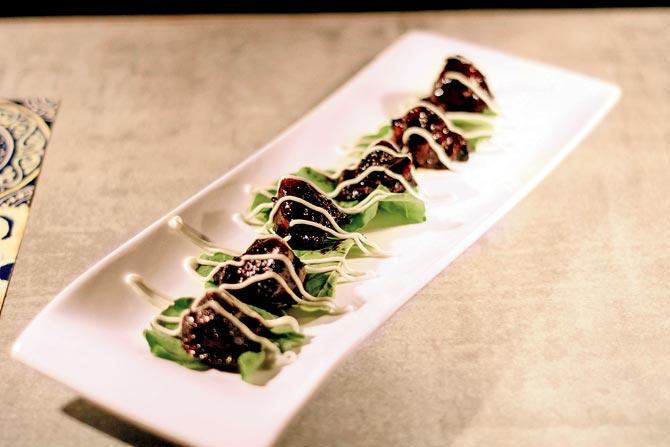 Pic/Bipin Kokate
Pic/Bipin Kokate
Dabrai is currently working on a nose to tail concept and plans to introduce it in a couple of months. "Pork nose to tails are popular, but we plan to do it with chicken. Today's diners are an adventurous lot. Some order it knowingly, while others agree to try it when we tell them about off cuts. The Indian mentality still remains that they will try cockroaches and bugs when they go abroad, but prefer expensive meat cuts back home."
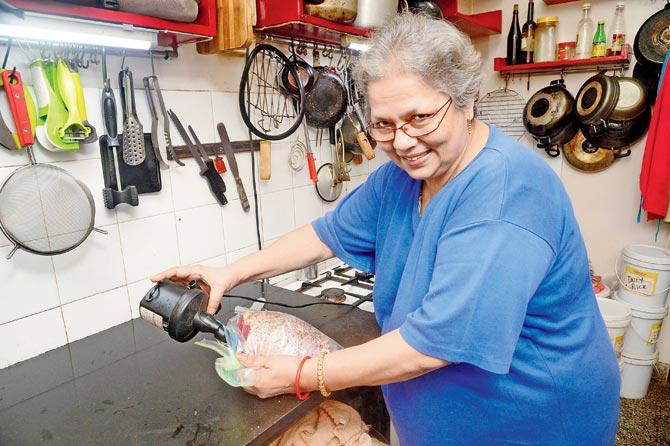
Pia Dasgupta working on the rump roast at her Bandra West residence. Pic/Datta Kumbhar
Gizzard curry and Kidney pudding Food Boutique
It has been 40 years since 65-year-old Promina Dasgupta, known as Pia in her circle, discovered the British-favourite Steak and Kidney Pudding. "It is not a kidney pie, mind you.
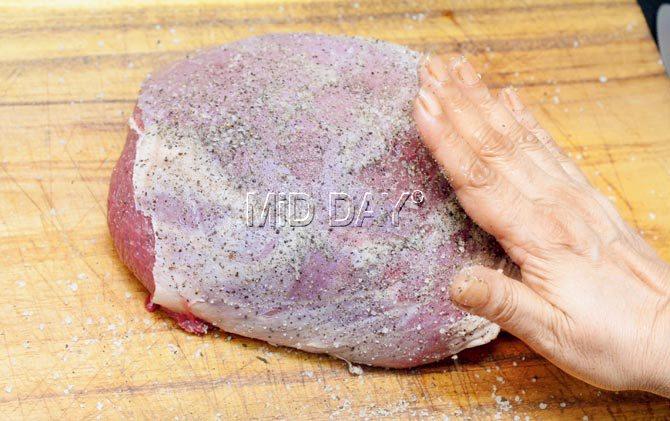 Chicken Gizzard. Pic/Datta Kumbhar
Chicken Gizzard. Pic/Datta Kumbhar
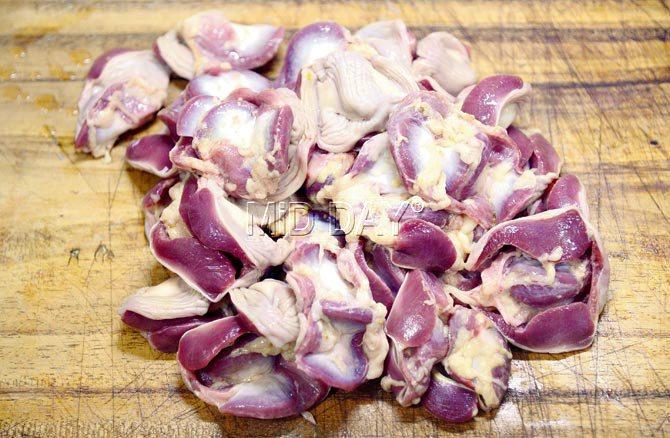 Chicken Gizzard. Pic/Datta Kumbhar
Chicken Gizzard. Pic/Datta Kumbhar
The pastry is a suet pastry made with flour and animal fat, not a puff pastry," she explains, poking a knife anxiously. It cuts with little resistance and sinks into a semi-dry kidney and meat, cooked in an onion-rich brown gravy. Her face breaks into a smile, satisfied. The savoury covering pastry melts in the mouth, filling the palate with a meaty starter, as the concentrated onion gravy offers a comfortably chewy kidney pie.
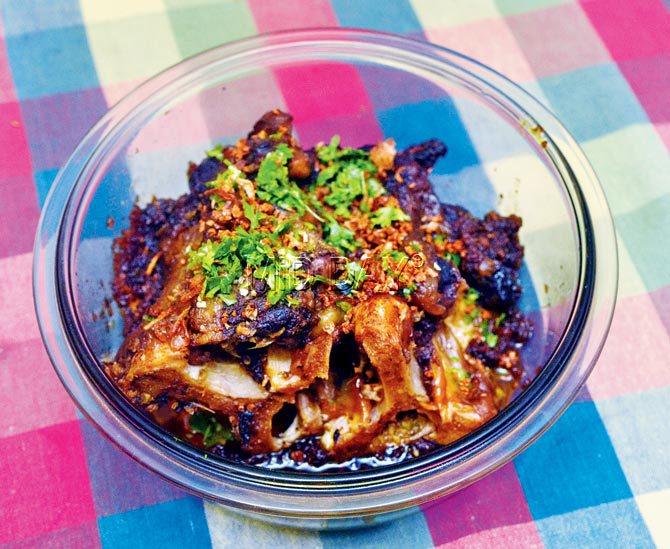 Oxtail tail curry. Pic/Datta Kumbhar
Oxtail tail curry. Pic/Datta Kumbhar
"Another dish we love is the tail curry, which I learned to cook while in Darjeeling. It has a fiery gravy made of mustard oil, curry, green chillies garlic and onions," offering us spoon. Hot, pungent and rustic, it takes two glasses of water to douse this fire. "People who can't afford expensive cuts survive on offals, or spares - a term I picked up only in Mumbai. It is a more economics driven need than religion/community driven," says Dasgupta, who has also made a gizzard or potta curry. She also made a rump roast to medium rare perfection in a sous vide for 16 hours. "My family eats the tongue too.
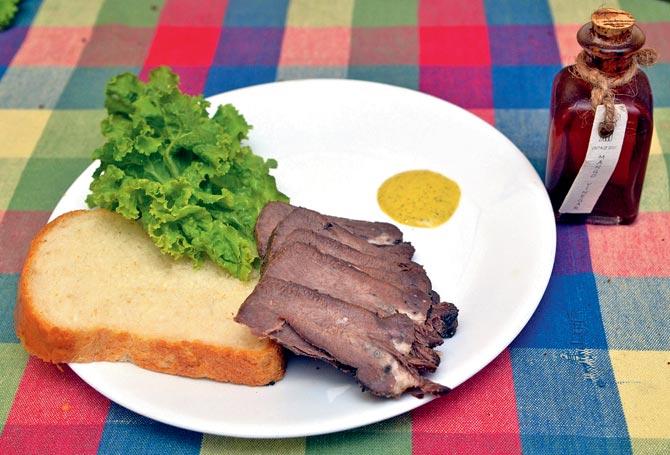 Boiled buffalo tongue. Pic/Datta Kumbhar
Boiled buffalo tongue. Pic/Datta Kumbhar
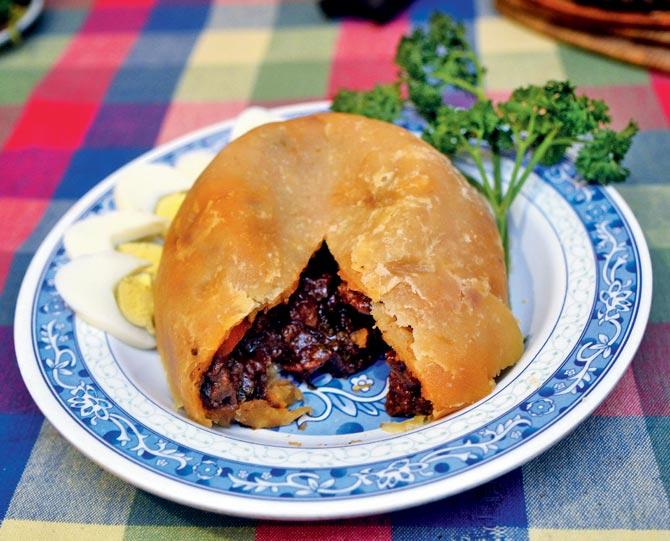 Kidney Pudding. Pic/Datta Kumbhar
Kidney Pudding. Pic/Datta Kumbhar
We like it just boiled, and relish it with mustard sauce, eggs and bread. I fed it to my aunt, who loved it and took home a piece too. When she found out it was tongue, she freaked out!" Pia laughs, adding that the goodies she has prepared today will be relished by Fidji and her. "My nine-year-old Pomeranian loves it."
 Blood Brain Barrier by Aditya Raghavan of Danda Project
Blood Brain Barrier by Aditya Raghavan of Danda Project
Blood Pasta by Danda Project
Last September, physicist Aditya Raghavan and his housemate and chef, Anandita Kamani, launched the Danda Project to explore their love for food. Over the last 10 months, they have organised pop-ups at their Khar home earning rave reviews for the seafood, pork and mutton nose to tail. In Mumbai, says Raghavan, non-vegetarian means chicken breast and boneless mutton cuts. "Blood, liver, head, kidney, brain trotters, gizzard, all come under off cuts and poor-class meats. When people are spending money, they want expensive stuff like chops, shank, shoulder and leg. When we do pop-ups, we use brain, liver, heart, applying off-cut based recipes," he adds. A dish the duo is proud of is the Blood Brain Barrier. "We make pasta using blood and flour, and a ravioli stuffed with poached brain. This, we finish with a panchphoran-infused brown butter sauce. We don't care about whether we'll find takers, since we do small groups, people who sign up know what they are in for, and there are many out there."
 The tacos served on bed of avocado mash and sour cream
The tacos served on bed of avocado mash and sour cream
Heart Crostini and Tacos with Jowl and Secret Cut
Offals and off-cuts, says Gresham Fernandes, have a stronger flavour and the meat takes longer to cook. The meat is often smoked before cooking. "We soak the kidney and liver in brine or salt solution to drain out the blood. In Europe, they follow a different school of thought, where they cook it on the grills for a few seconds and serve it," he says.
 The pork liver sausages marinated in a kala masala
The pork liver sausages marinated in a kala masala
Christmas, for the chef, means sarpotel, cooked in blood, heart and liver. "My grandfather used to make a mean blood sausage, but we don't make it anymore as you don't get fresh pigs in the city. They come from Pune instead." Even the fish, he says, is utilised thoroughly. "We have the eggs, collars, head, scales and bones. When we confit our duck, my kitchen boys stir fry the bone," he adds.
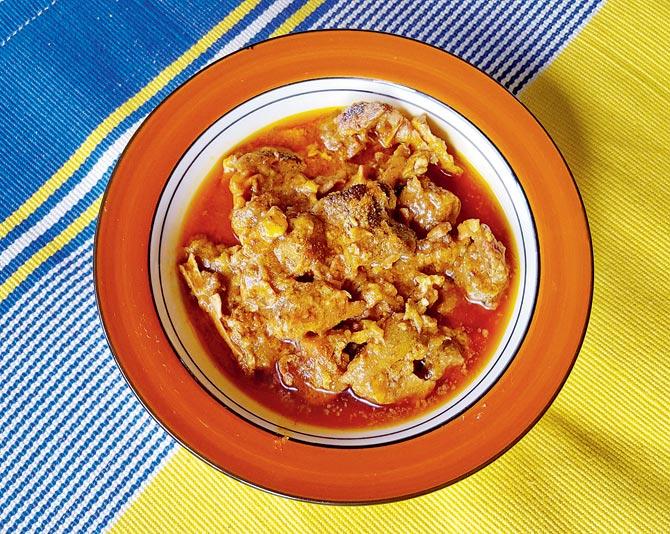 Pasoni Bhoja from Bodo tribe consists of pork trotters, offals and brain
Pasoni Bhoja from Bodo tribe consists of pork trotters, offals and brain
Pasoni Bhoja from Bodo tribe and Khasi Jadoh
Tribals, says home chef Gitika Saikia, do not believe in throwing away any meat part. "I hail from Assam, and my elders tell me that hunting tribes would not get an animal every day, and so nothing was thrown away. Whatever meat is available, you place the parts over your cooking range so they don't go bad. People here find it amusing to see food products like chorizos and sausages. I was in the market yesterday, and the lady had cut up the pork intestines, trotters, brain and offal. It is not exotic for them," says Saikia, who has just returned from a research trip from Tezpur, where her husband's family resides. For her Eight Sisters pop-up, she often serves pork trotters, or pig legs. "They require slow cooking, and at least 10-15 whistles in the pressure cooker. By the time they are done, the bones are so soft, you can chew them. Another traditional dish is the Khasi jadoh, made from pork blood. We make rice with pork blood and gizzard, and cook it in a pork broth with lots of black sesame."
 Subscribe today by clicking the link and stay updated with the latest news!" Click here!
Subscribe today by clicking the link and stay updated with the latest news!" Click here!






